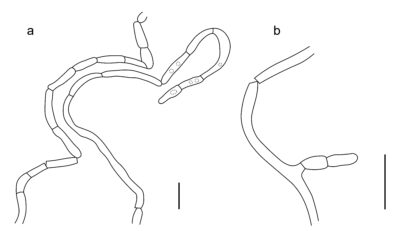Fungalpedia – Note 394, Monticola
Monticola Selbmann & Egidi
Citation when using this data: Tibpromma et al. 2024 (in prep.) – Fungalpedia, Rock-inhabiting fungi.
Index Fungorum, Facesoffungi, MycoBank, GenBank, Fig. 1
Classification: Incertae sedis, Capnodiales, Dothideomycetidae, Dothideomycetes, Pezizomycotina, Ascomycota, Fungi
Based on Bayesian analyses of LSU, rpb2, ITS, and BT2 sequences, Egidi et al. (2014) introduced Monticola, with Monticolaelongata as the type species, within the Teratosphaeriaceae. This was further acknowledged in subsequent studies by Wijayawardene et al. (2014, 2022) and Crous et al. (2019). Monticola is a monotypic genus, based solely on the species M. elongata, which was isolated from rocks in Antarctica and mountain tops, environments characterized by extremely cold temperatures for the majority of the year. Monticola is distinguished by its slow-growing, greyish-black colonies with a sharp margin. The colonies are greyish on the obverse, raised in the center, and flat near the periphery, with the reverse side being black. The hyphae of Monticola are thick-walled, branched, elongated, and eventually disarticulate into separate cells. The conidiophores are micronematous and the conidia are thallic-arthric, releasing reluctantly. The teleomorph stage of Monticola remains unknown. Initially, the nomenclature for the genus Monticola was considered invalid under Article 40.7 (Shenzhen) of the nomenclatural rules due to procedural issues in its introduction by Egidi et al. (2014). However, this issue was addressed by Crous et al. (2019), who validated the name Monticola, rectifying the initial oversight and establishing it as a validly named genus.
Type species: Monticola elongata L. Selbmann & E. Egidi
Other accepted species: This genus is monotypic.
Figure 1 – Monticola elongata. a, b Micronematous conidiophores and arthroconidia. Scale bars: a–f = 10 μm. Redrawn from Egidi et al. (2014).
References
Entry by
Wanasinghe DN, Center for Mountain Futures, Kunming Institute of Botany, Chinese Academy of Sciences, Honghe 654400, China.
(Edited by Saowaluck Tibpromma, Samaneh Chaharmiri-Dokhaharani, & Achala R. Rathnayaka)
Published online 26 November 2024
